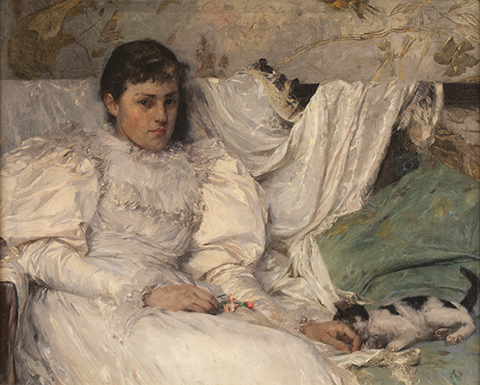What is it?
Artist
Carl von Marr (Milwaukee 1858–1936 Munich)
Title
A Wistful Moment
Year
1892
Medium
Oil on canvas
Dimensions
20 3/8 x 25 1/4 in.
Credit line
Gifted 1999, Paul J. Collins in honor of Curtis and Adele Collins
About the Work
About

Carl von Marr’s A Wistful Moment is one of his most intriguing portraits with richly layered references and allusions. In the left half of the canvas, a fashionable young lady in a white dress slouches at the end of a settee draped with white and green fabrics. She absentmindedly plays with a black and white kitten. Behind her is a Japanese screen. The trappings suggest wealth, yet the subject is remarkably casual in her demeanor.
As in other portraits by Von Marr, the influence of James McNeill Whistler (1834 – 1903) is here evident. In the mid-1860s, Whistler executed three portraits of young women wearing white dresses, often accompanied by Japanese objects such as fans or vases. Each painting had “Symphony in White” as part of its title. They were portraits but also and equally aesthetic studies of white as a color. Symphony in White No. 2, The Little White Girl (1864) was shown in Munich in 1892, the year Von Marr painted A Wistful Moment. The portrait’s shifting white palette also more broadly aligns Von Marr with Impressionist styles then sweeping Europe.
White dresses, which were difficult to launder, had not yet come to signify marriage but rather wealth and status and the availability of servants. In this context, Von Marr’s portrait may also allude to neurasthenia (or Americanitis), a condition in the late nineteenth century often ascribed to the upper classes that were deemed incapable of dealing with the rigors and stress of modern life. American painters Thomas Eakins, Henry Ossawa Tanner, Eastman Johnson, and Thomas Wilmer Dewing all produced paintings of women with similar telling characteristics: contemplative downcast gaze, downward-tilted head, and a slouching posture.
Philanthropist Phoebe Hearst purchased the painting in 1892 when she traveled to Munich to recuperate in the Bavarian baths following the death of her husband William Randolph Hearst in 1891. Then forty-eight years old, Hearst is unlikely the sitter, despite a mutual fondness for the artist. She commissioned several paintings from him and he visited her in 1893 in California.
